| کد مقاله | کد نشریه | سال انتشار | مقاله انگلیسی | نسخه تمام متن |
|---|---|---|---|---|
| 6408461 | 1629453 | 2016 | 8 صفحه PDF | دانلود رایگان |
- Glyphosate was strongly sorbed in all the studied soils.
- The Kf was influenced positively by clay content, and negatively by the soil pH and P-Bray.
- Small amounts of glyphosate were transported through the undisturbed columns.
- Most of the glyphosate and AMPA was found in the top 5Â cm of the soil columns.
- Tillage practice did not have an influence in the leaching of glyphosate.
Glyphosate (N-(phosphonomethyl) glycine) is a post-emergence, non-selective, foliar herbicide. Around 200 million liters of this herbicide are applied every year in Argentina, where the main agricultural practice is no-till (NT), accounting for 78.5% of the cultivated land. In this work, we studied the adsorption of glyphosate in different soils under long-term management (more than 16 years) of NT and conventional tillage (CT). Samples were taken from different regions of Argentina corresponding to: Paraná soil (PAR), a silty clay loam soil (< 37% clay), Manfredi (MAN) and Pergamino (PER), both silty loam soils (< 26% clay). We found that the adsorption was very high in all the soils, and it was particularly influenced by the soil clay content and CEC and negatively related to pH and phosphorus. In general, the adsorption coefficient (Kf) was higher in the CT samples. We also studied the vertical transport of glyphosate in undisturbed columns (15 cm long) and compared the effect of NT and CT. Less than 0.24% of the applied pesticide leached in all soils. No significant difference was found between the total amount of leached glyphosate between soils or tillage practice. The highest glyphosate concentration (67.53% of the initially applied doses) was found in the top 5 cm of the columns. The strong retention of glyphosate to the soil matrix, as confirmed by the high Kf values obtained in the isotherm studies, was the dominant factor influencing glyphosate mobility through the soil profile.
Journal: Geoderma - Volume 263, 1 February 2016, Pages 78-85
